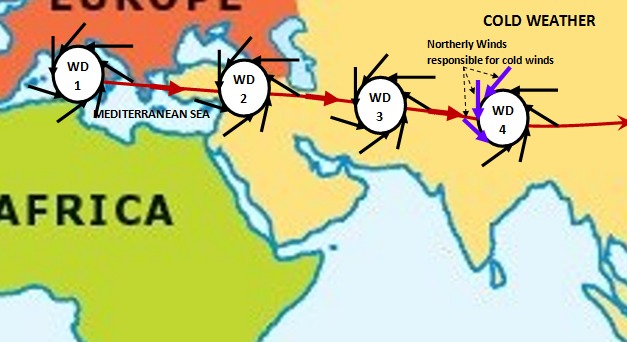What is Western Disturbance? What Are It’s Effect Over India?
During winter we often see sometimes that there are sharp decrease in temperature causing cold wave conditions. Do you want to know why it happens? It is due to a low pressure system over north known as Western Disturbance.
What is Western Disturbance (W.D.)?
Western Disturbance is an extra tropical storm, which give rain to North and Northwest India during winter. It is very useful for wheat and winter crops. It is driven by westerlies (westerlies, are prevailing winds from the west toward the east in the middle latitudes between 30 and 60 degrees latitude.)

Western Disturbance originate from Mediterranean sea, Black sea and Caspiun sea. From this region and from Atlantic ocean it collect the moisture and move eastward.
In the extra tropical zone frontogenesis (a process in which two air masses of different densities come together to form a front) process take place which in turn facilitate the formation of cyclone. These type of cyclones occuring over mid latitude are called extra tropical cyclone. They travel as a family and reaching north India one by one. They are more in frequency in the winter season as westerlies are stronger in winter. They are approaching India by travelling across Iraq, Iran, Afghanistan and Pakistan. They are mainly lower tropospheric system that show variation in strength and vertical extent with super imposition of mid and upper tropospheric trough in westerlies.
Cold Wave Conditions Due to Western Disturbance (WD)
The approach of WD is characterised by rise in minimum temperature and occurrence of rainfall. But once the WD crosses a place then minimum temperature starts dropping. The formation of fog starts and slowly the cold wave occurs spreading to southwards in the country.
The reason for cold condition is shown in the figure WD-4. When WD passes, at the rear of it the winds are Northerly or Northeasterly bringing the cold air from the north. Since through the country the winds are mostly northerly or northeasterly, so this cold air spreads over central and sometimes peninsular parts causing drop in temperature. If there is considerable drop by 6 deg C to 7 deg C in minimum temperature from its normal then we call it as Cold Wave Conditions.
In winter we hear that Kashmir receives heavy snowfall. So this is the indication that WD had passed over Kashmir and most of the parts of the country to be in grip of cold wave conditions. The intensity of cold wave over country depends on the wind pattern.





